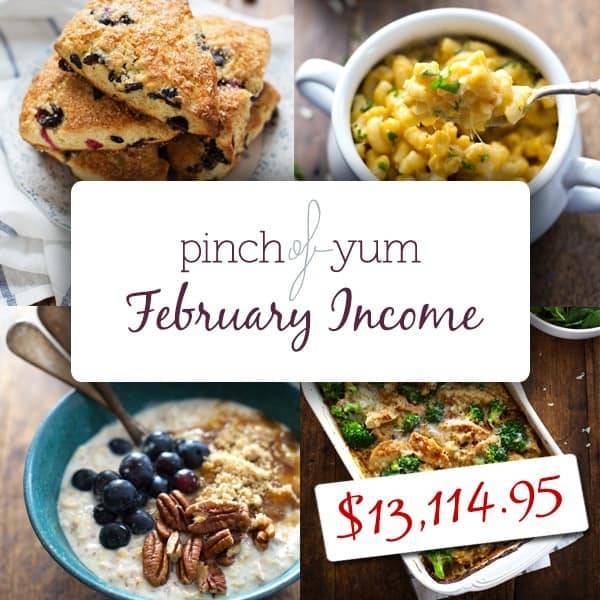
Hey there friends! It’s Bjork, checking in for Pinch of Yum’s monthly traffic and income report.
I have many roles here at Pinch of Yum. I consider the most important to be my role as CTT (chief taste tester). It’s a tough job, but somebody has to do it. Along with my role as CTT, I also partner with Lindsay to figure out ways to grow Pinch of Yum: grow the traffic, grow the income, and (probably most importantly) grow our connection with you, the readers!
In these monthly reports, I give a behind the scenes look at Pinch of Yum. I share what’s working and what’s not working. In this post, I want to take some time to share what we think might work. It’ll be a sneak peek at the projects and ideas that Lindsay and I are talking about over the dinner table and working on in our free time.
Most of these projects are still in the “currently building and a little bit embarrassing” stage. Some of them might turn into something really cool and some of them might be things that we sweep under the virtual living room rug. My hope in sharing these projects is that you’re inspired to create new things and continually reinvent yourself (and your blog).
But first, the numbers.
Income
- BlogHer – $3,896.93
- Tasty Food Photography – $3,050.40
- Bluehost – $3,065.00
- Google AdSense – $1,624.82
- sovrn (formerly Lijit) – $1,264.27
- Ziplist – $1,003.95
- Swoop (BlogHer) – $872.42
- The Creamy Cauliflower Sauce eCookbook – $832.50
- Genesis Theme – $652.08
- MediaTemple – $160.00
- Thesis Theme – $114.84
- Elegant Themes – $64.00
Total Income:: $16,601.21
Expenses
- Media Temple (Hosting) – $750.00
- Food Expenses- $652.14
- eBook Affiliates – $540.70
- Support Staff – $433.28
- Amazon S3 and Cloudfront – $409.94
- New Site Development – $229
- PayPal Transaction Percentage – $197.74
- Adobe Creative Cloud – $53.55
- Misc. Expenses – $51.99
- PayPal Website Payments Pro – $30.00
- ViralTag – $28.00
- QuickBooks – $26.95
- Treehouse – $25.00
- Time Doctor – $19.98
- VaultPress – $15.00
- E-Junkie – $15.00
- Rafflecopter – $7.99
Total Expenses: $3,486.26
Net Profit: $13,114.95
If you’re interested in learning more about some of the ways that you can monetize a food blog, we encourage you to download this free ebook, “16 Ways to Monetize Your Food Blog,” from our sister site, Food Blogger Pro!
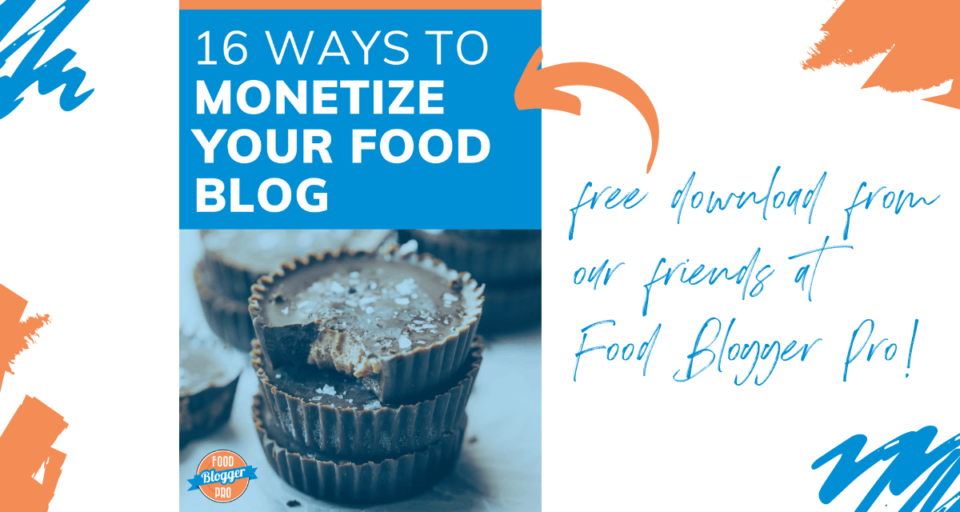
Thoughts On Income
Display Advertisers
As expected, February was another low month for display advertising. This happens for a number of reasons, but the primary reason is the ad budget cycle. Jason from Pro Blog School (and 100 Days of Real Food) does a great job of explaining why this happens in this post –> I Freaked When Ad Revenue Dropped in January. Now I Know Why. I won’t repeat what he wrote. Just be sure to check out the section called “The Ad Budget Cycle.”
We’ve started to see earnings recover as we’ve moved into March, which is always a good feeling.
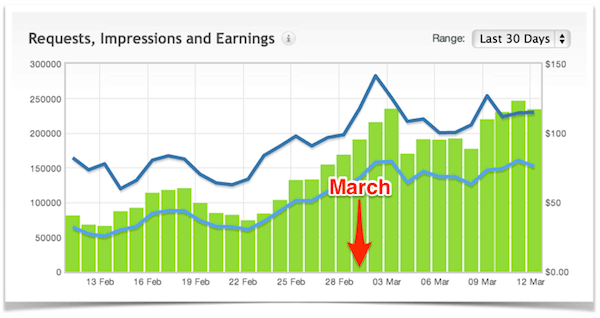
Hosting Expenses
We pay a lot for hosting. As a matter of fact, over the past few months, our hosting bill was higher than what we paid per month for our first home!
I’ve been trying to find the sweet spot with hosting, making sure that we have a sufficient server without overspending. My gut is that we’ve been on the overspending side, so I decided to test out a more affordable plan and see how it plays out. I’m keeping a close eye on how this change impacts the site load time in Google Analytics.
Here’s a screenshot of the site load time for Pinch of Yum. The arrow points to the day we switched the server to a more affordable plan.

That tiny little note icon you see below the arrow is called an annotation. I’d recommend using those often in Google Analytics to keep track of changes that you make with your blog. This allows you to easily track changes and see the impact that they have on your blog.
Note: Here’s a tutorial from Google on how to add an annotation in Google Analytics.
You can track load time in Google Analytics by going to Behavior > Site Speed > Overview.

I should say this because I’m sure that many of you noticed: Pinch of Yum’s site load speed is terrible. Like, really bad. I think it’s due to the number of pictures, the quality of the pictures (general pretty high), and the number of ads that we run on the site. All in all, it makes for really slow load time.
Have you ever checked the load time on your site? What is it? What have you done to help improve it?
I’d love to hear about your experience in the comments section. I’ll be sure to let you know if we find some good solutions.
Rpm
RPM stands for page revenue per thousand impressions.
I’m going to start including Pinch of Yum’s RPM in every income and traffic report. I think it’s an important metric for people to understand, and it’s a great way to track how effective you are at monetizing the page views on your blog.
In February we had an RPM of $7.95.

If you want to learn more about RPM (and some other important advertising terms) then be sure to check out this post on Food Blogger Pro.
Why is RPM important? I talked about it in last month’s report, but it’s an important concept so I want to be sure to explain it again. I think the coolest thing about RPM is that it helps to show what you could have earned in a given month. For instance, I can look back at a previous month and use the RPM from that month to project potential earnings.
Here’s an example: In December, Pinch of Yum had an RPM of $15.31. Assuming that (1) traffic to Pinch of Yum will be similar in December 2014 as it was in February 2014 and (2) that the RPM will be similar in December 2014 to what it was in December 2013 (which I think it will be), we can project the total revenue for December 2014 to be at (or above, if traffic goes up) $31,955.34.
((December 2013 RPM) / 1,000) * (February 2014 page views)) = Projected RPM
with numbers:
($15.31 / 1,000) * 2,087,220 = $31,955.34
That’s a lot of assuming, but I’ll be interested to see how close I am with that number when I write the December 2014 income and traffic report. 🙂

Ladies and gentleman, my first ever meme. Linds is going to love that one.
Traffic
Below are some screenshots from Google Analytics.
Traffic Overview

Top Ten Traffic Sources
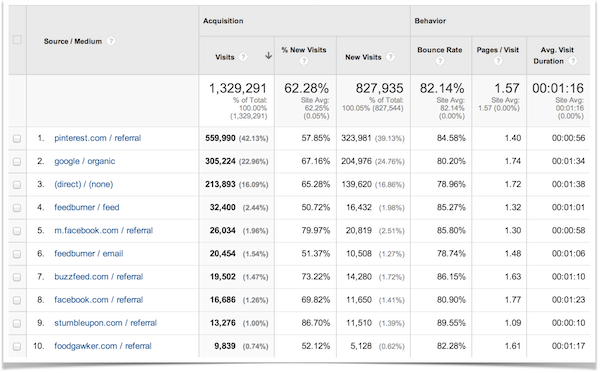
Mobile vs. Desktop Traffic

Thoughts On Traffic
The Pinterest numbers still scare every time I see them. It’s not a matter of if those will start to decline, it’s a matter of when those will start to decline.
In November’s report, I talked about our decision to intentionally grow the Pinch of Yum Facebook page, but recent changes with Facebook make it seem like Facebook is making it harder and harder for brands to reach fans (without paying a fee for it). This makes it harder to justify spending a lot of time and energy investing in that platform.
One of the projects I’ll be sharing below has to do with a move that will distribute some of the eggs we have in the Pinterest basket.
Projects and New Stuff
I wanted to take some time to share three of the projects/ideas that Lindsay and I are working on. Some of these things might happen, others might not. I’m sharing these so you can see what it’s like at the very beginning stages of a project for us. In short, it’s not very glamorous. 🙂 I’ve found that creating something new usually comes about by (1) saying yes and then (2) intentionally taking steps forward every day, even if they’re small steps. This has proven to be true so far with these three projects.
1. Studio Space

Those of you that follow Lindsay on Instagram or Facebook might have noticed that we’ve been looking into different studio spaces. The studio space would allow us to create a permanent “Pinch of Yum space” to set up for photography and video. The latter of which (video) I’d like to chat about.
I’ve brought up video a lot in these monthly reports. Here’s why I think it’s important: As more and more recipes are posted online the value of a recipe will go down. The supply of online recipes will continue to climb, which means they’ll become more of a commodity, which means that there will be lots of display advertising space available because of the massive number of recipes that are available online. For advertisers, a click is a click, regardless of its coming from a popular blog or a brand new blog. If someone is willing to get paid poorly for displaying ads on their site, then the advertiser is okay with that and will happily pay less. The more content that is created the more people there are that are okay getting paid really poorly for displaying ads on their site.
So why is video so important?
Video is important because the thing that’s in high demand online is trust and connection, and one of the best ways to establish trust and connection online is through the use of video. The other advantage with video is that the barrier to entry is higher, which means that fewer people will do it. If you’re able to create something that’s in high demand (trust and connection), and not as many people are doing it (supply), then you’re in a good place.
So far the studio space stuff has been “just looking.” When we do finally decide on a space we’ll have to add a kitchen, which will most likely result in a month with a negative income report (gulp).
Nutrition Label Generator
We’ve been working for a long time on creating a nutrition label generator for Food Blogger Pro. It’s a very basic version that is still buggy, but you get what we’re going for.
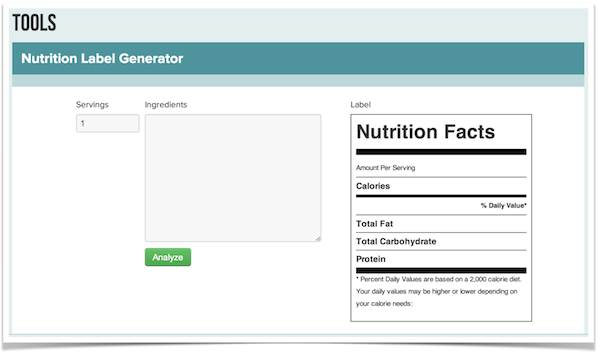
This is the first time that I’ve ever worked with developers to create a web application. It’s been slower than I hoped, but we’re continuing to move forward with it. I’m excited about the potential of continuing to add web applications like this to Food Blogger Pro in an effort to continue to build the site into an awesome resource for food bloggers.
Coupon Pinch
Coupon Pinch is a deals and discounts site that I’ve been working on that will focus on the kitchen and food niche. The site is still very new. The system is all set up, but lots of the pages are still populated with the theme’s default content. You can take a look, but know that it’s like looking at a house that doesn’t have the walls up yet.
Here’s the thing about Coupon Pinch: there are thousands of coupon sites out there, and most of them don’t add much value. The biggest thing that I need to figure out with Coupon Pinch is how it can be a value-adding website. What is it about this site that will set it apart from the 1,000,000 other coupon sites that already exist? I don’t have a good answer yet, but I have some ideas.
I’ll be sure to keep you updated on this site if anything significant happens with it.
But Wait, There’s More!
I’ve started to publish a weekly post over on the Food Blogger Pro blog. The posts have similar content to these monthly income and traffic reports. Here are the posts that were published in February:
Feb. 5th: A Huge SEO Tip That Most Food Bloggers Miss
Feb. 12th: Don’t Track Yourself: How to Block Yourself from Google Analytics
Feb 19th: 5 ways to make more money from your food blog
Feb. 26th: The Ideal Search Result for Food Bloggers (and How to Get it for Your Blog)
Because Of You
It’s really true. It’s because of you (yes, you!) that this thing we call Pinch of Yum can exist as it does today. Thanks so much for reading, tweeting, commenting or emailing. We love hearing from you!
We’re using a portion of this month’s income from Pinch of Yum to support a special project at the Children’s Shelter of Cebu, an orphanage where Lindsay and I lived and worked for a year. The special project we’re supporting this month is new bunk beds.

Every kid at CSC has their own bunk bed. It’s the one space at the orphanage that they can claim as their own personal space. Almost every kid keeps their books, drawings, photos, and toys tucked away underneath their mattress for safekeeping. The beds in some of the houses are starting to get worn out, so we’re excited to help support CSC as they raise money for a new set of beds. 🙂
